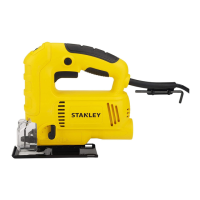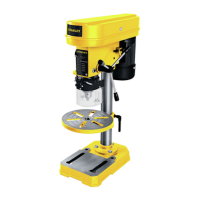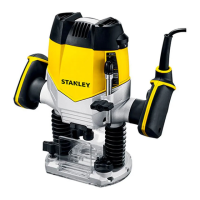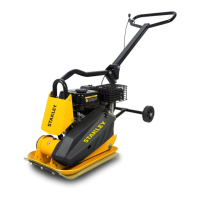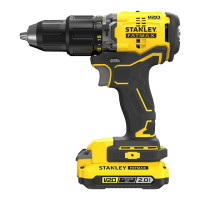9
ENGLISH
Sawing
Hold the tool firmly with both hands while cutting (Fig.H).
The shoe plate (9) should be held firmly against the
material being cut. This will help prevent the saw from
jumping, reduce vibration and minimise blade breakage.
♦ Let the blade run freely for a few seconds before
starting the cut.
♦ Apply only a gentle pressure to the tool while
performing the cut.
Hints for optimum use
Sawing laminates
When cutting laminates, splintering may occur which can
damage the presentation surface. The most common saw
blades cut on the upward stroke, therefore if the shoe plate
is sitting on the presentation surface either use a saw
blade that cuts on the downward stroke or:
♦ Use a fine-tooth saw blade.
♦ Saw from the back surface of the workpiece.
♦ To minimise splintering, clamp a piece of scrap wood
or hardboard to both sides of the workpiece and saw
through this sandwich.
Sawing metal
Warning! Do not use a vacuum when cutting metal. Metal
filings will be hot and may cause fire.
Be aware that sawing metal takes much more time than
sawing wood.
♦ Use a saw blade suitable for sawing metal.
♦ When cutting thin sheet metal, clamp a piece of scrap
wood to the back surface of the workpiece and cut
through this sandwich.
♦ Spread a film of oil along the intended line of cut.
Rip Fence (optional)
♦ Ripping and circle cutting without a pencil line are
easily done with a rip fence and circle guide (optional
spare part).
Attaching Rip Fence (Figs. I )
♦ Insert rip fence (17) into the shoe plate slots with the
cross bar facing down as shown in figure I.
♦ Place screw (18) into hole in bottom of shoe plate.
♦ Align clamp bar (19) over screw with lipped edge facing
down and pointing towards the rear of the saw.
♦ Using a phillips screwdriver, run the screw into the
threaded hole in the bar clamp.
♦ Adjust to width of cut and tighten screw.
Circle Cutting (Fig. J)
♦ Insert rip fence into slot on the right side of shoe plate
with cross bar facing up.
♦ Adjust rip fence so that distance from blade to hole in
cross bar is the desired radius and tighten screw.
♦ Place saw so that centre of hole in cross bar is over
centre of circle to be cut (make plunge cut, drill hole for
blade or cut inward from edge of material to get blade
into position).
♦ When saw is properly positioned, drive a small nail
through hole in cross bar into exact centre of circle to
be cut.
♦ Using rip fence as a pivot arm, begin cutting circle.
MAINTENANCE
Your STANLEY power tool has been designed to operate
over a long period of time with a minimum of maintenance.
Continuous satisfactory operation depends upon proper
tool care and regular cleaning.
♦ Regularly clean the ventilation slots in your tool using
a soft brush or dry cloth.
♦ Regularly clean the motor housing using a damp cloth.
Do not use any abrasive or solvent-based cleaner.This
machine is not user-serviceable. If problems occur
contact an authorised repair agent.
Lubrication
Your power tool requires no additional lubrication.
Cleaning
WARNING: Blow dirt and dust out of the main
housing with dry air as often as dirt is seen
collecting in and around the air vents. Wear
approved eye protection and approved dust
mask when performing this procedure.
WARNING: Never use solvents or other harsh
chemicals for cleaning the non-metallic parts of
the tool. These chemicals may weaken the
materials used in these parts. Use a cloth
dampened only with water and mild soap. Never
let any liquid get inside the tool; never immerse any part of
the tool into a liquid.
To maintain products SAFETY and RELIABILITY,
repair, carbon brush inspection and replacement, any
other maintenance or adjustment should be performed
by STANLEY Service Centers, always using Stanley
replacement parts.
Optional Accessories
WARNING: Since accessories, other than those
offered by STANLEY, have not been tested with
this product, use of such accessories with this
tool could be hazardous. To reduce the risk of injury, only
STANLEY, recommended accessories should be used
with this product.
Consult your dealer for further information on the
appropriate accessories.
Protecting The Environment
Separate collection. This product must not be
disposed of with normal household waste.
Should you find one day that your STANLEY product
needs replacement, or if it is of no further use to you, do
not dispose of it with household waste. Please sort it out
for separate recycling.
